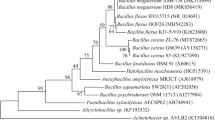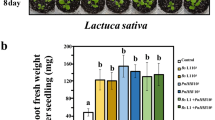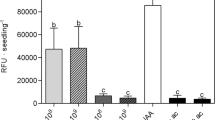Abstract
Strains of Bacillus thuringiensis (Bt) are commonly commercialized as bioinoculants for insect pest control, but their benefits go beyond their insecticidal property: they can act as plant growth-promoters. Auxins play a major role in the plant growth promotion. However, the mechanism of auxin production by the Bacilli group, and more specifically by Bt strains, is unclear. In previous work, the plant growth-promoting rhizobacterium (PGPR) B. thuringiensis strain RZ2MS9 increased the corn roots. This drew our attention to the strain’s auxin production trait, earlier detected in vitro. Here, we demonstrate that in its genome, RZ2MS9 harbours the complete set of genes required in two pathways that are used for Indole acetic acid (IAA) production. We also detected that the strain produces almost five times more IAA during the stationary phase. The bacterial application increased the shoot dry weight of the Micro-Tom (MT) tomato by 24%. The application also modified MT root architecture, with an increase of 26% in the average lateral root length and inhibition of the axial root. At the cellular level, RZ2MS9-treated MT plants presented elongated root cortical cells with intensified mitotic activity. Altogether, these are the best characterized auxin-associated phenotypes. Besides that, no growth alteration was detected in the auxin-insensitive diageotropic (dgt) plants either with or without the RZ2MS9 inoculation. Our results suggest that auxins play an important role in the ability of B. thuringiensis RZ2MS9 to promote MT growth and provide a better understanding of the auxin production mechanism by a Bt strain.

adapted from Zhang et al. (2019). Arrows with solid lines indicate the enzymes which genes were detected in the B. thuringiensis RZ2MS9 genome. Arrows with dashed lines indicate the enzymes which genes were not detected in RZ2MS9 genome. ORD, oxidoreductase; IAOxD, indole-3-acetaldoxime dehydratase; TMO, tryptophan-2-monooxygenase; IAH, indole-3-acetamide hydrolase; AAT, aromatic amino transferase; IPDC, indole-3-pyruvate decarboxylase; ALDH, aldehyde dehydrogenase; TDC, tryptophan decarboxylase; MAO, monoamine oxidase




Similar content being viewed by others
Availability of data and material
All data generated or analysed during this study are included in this published article and its supplementary information files.
References
Ahmed A, Hasnain S (2014) Auxins as one of the factors of plant growth improvement by plant growth promoting rhizobacteria. Pol J Microbiol 63:261–266. https://doi.org/10.33073/pjm-2014-035
Ali B (2015) Bacterial auxin signaling: comparative study of growth induction in Arabidopsis thaliana and Triticum aestivum. Turk J Bot 39:1–9. https://doi.org/10.3906/bot-1401-31
Ali B, Sabri AN, Ljung K, Hasnain S (2009) Quantification of indole-3-acetic acid from plant associated Bacillus spp. and their phytostimulatory effect on Vigna radiata (L.). World J Microb Biot 25:519–526. https://doi.org/10.1007/s11274-008-9918-9
Armada E, Azcón R, López-Castillo OM, Calvo-Polanco M, Ruiz-Lozano JM (2015) Autochthonous arbuscular mycorrhizal fungi and Bacillus thuringiensis from a degraded Mediterranean area can be used to improve physiological traits and performance of a plant of agronomic interest under drought conditions. Plant Physiol Biochem 90:64–74. https://doi.org/10.1016/j.plaphy.2015.03.004
Baca BE, Soto-Urzua L, Xochihua-Corona YG, Cuervo-Garcia A (1994) Characterization of two aromatic amino acid aminotransferases and production of indoleacetic acid in Azospirillum strains. Soil Biol Biochem 26:57–63. https://doi.org/10.1016/0038-0717(94)90195-3
Baek I, Lee K, Goodfellow M, Chun J (2019) Comparative genomic and phylogenomic analyses clarify relationships within and between Bacillus cereus and Bacillus thuringiensis: proposal for the recognition of two Bacillus thuringiensis genomovars. Front Microbiol 10:1978. https://doi.org/10.3389/fmicb.2019.01978
Batista BD, Lacava PT, Ferrari A, Teixeira-Silva NS, Bonatelli ML, Tsui S, Mondin M, Kitajima EW, Pereira JO, Azevedo JL, Quecine MC (2018) Screening of tropically derived, multi-trait plant growth-promoting rhizobacteria and evaluation of corn and soybean colonization ability. Microbiol Res 206:33–42. https://doi.org/10.1016/j.micres.2017.09.007
Bazinet A (2017) Pan-genome and phylogeny of Bacillus cereus sensu lato. BMC Evol Biol 17:176. https://doi.org/10.1186/s12862-017-1020-1
Bergfeld R, Speth V, Schopfer P (1988) Reorientation of microfibrils and microtubules at the outer epidermal wall of maize coleoptiles during auxin-mediated growth. Bot Acta 101:57–67. https://doi.org/10.1111/j.1438-8677.1988.tb00012.x
Bloemberg GV, Lugtenberg BJ (2001) Molecular basis of plant growth promotion and biocontrol by rhizobacteria. Curr Opin Plant Biol 4:343–350. https://doi.org/10.1016/S1369-5266(00)00183-7
Bonatelli ML, Li J, Dumaresq A, Quecine MC, Settles Matthew L (2020) Complete genome sequence of Bacillus sp. strain RZ2MS9, a multi-trait plant growth promoter. Microbiol Resour Announc 9:e00623-e720. https://doi.org/10.1128/MRA.00623-20
Boyer M, Bally R, Perrotto S, Chaintreuil C, Wisniewski-Dyé F (2008) A quorum-quenching approach to identify quorum-sensing-regulated functions in Azospirillum lipoferum. Res Microbiol 159:699–708. https://doi.org/10.1016/j.resmic.2008.08.003
Brandl MT, Lindow SE (1998) Contribution of indole-3-acetic acid production to the epiphytic fitness of Erwinia herbicola. Appl Environ Microbiol 64:3256–3263. https://doi.org/10.1128/AEM.64.9.3256-3263.1998
Bunsangiam S, Sakpuntoon V, Srisuk N, Ohashi T, Fujiyama K, Limtong S (2019) Biosynthetic pathway of indole-3-acetic acid in basidiomycetous yeast Rhodosporidiobolus fluvialis. Mycobiol 47:292–300. https://doi.org/10.1080/12298093.2019.1638672
Campos ML, Carvalho RF, Benedito VA, Peres LEP (2010) Small and remarkable: the micro-Tom model system as a tool to discover novel hormonal functions and interactions. Plant Signal Behav 5:267–270. https://doi.org/10.4161/psb.5.3.10622
Canellas LP, Dantas DJ, Aguiar NO et al (2011) Probing the hormonal activity of fractionated molecular humic components in tomato auxin mutants. Ann Appl Biol 159:202–211. https://doi.org/10.1111/j.1744-7348.2011.00487.x
Carroll LM, Wiedmann M, Kovac J (2020) Proposal of a taxonomic nomenclature for the Bacillus cereus group which reconciles genomic definitions of bacterial species with clinical and industrial phenotypes. Mbio 11:e00034-e120. https://doi.org/10.1128/mBio.00034-20
Carvalho RF, Campos ML, Pino LE et al (2011) Convergence of developmental mutants into a single tomato model system: “Micro-Tom” as an effective toolkit for plant development research. Plant Methods 7:18. https://doi.org/10.1186/1746-4811-7-18
Cassán F, Vanderleyden J, Spaepen S (2014) Physiological and agronomical aspects of phytohormone production by model Plant-growth-promoting rhizobacteria (PGPR) belonging to the genus Azospirillum. J Plant Growth Regul 33:440–459. https://doi.org/10.1007/s00344-013-9362-4
Chu Z, Munir S, Zhao G et al (2020) Linking phytohormones with growth, transport activity and metabolic responses to cadmium in tomato. Plant Growth Regul 90:557–569. https://doi.org/10.1007/s10725-020-00580-w
Daniel SG, Rayle DL, Cleland RE (1989) Auxin physiology of the tomato mutant diageotropica. Plant Physiol 91:804–807. https://doi.org/10.1104/pp.91.3.804
Dobbelaere S, Croonenborghs A, Thys A, Broek AV, Vanderleyden J (1999) Phytostimulatory effect of Azospirillum brasilense wild type and mutant strains altered in IAA production on wheat. Plant Soil 212:153–162. https://doi.org/10.1023/A:1004658000815
Dobbss LB, Medici LO, Peres LEP, Pino-Nunes LE, Rumjanek VM, Façanha AR, Canellas LP (2007) Changes in root development of Arabidopsis promoted by organic matter from oxisols. Ann Appl Biol 151:199–211. https://doi.org/10.1111/j.1744-7348.2007.00166.x
Ehling-Schulz M, Lereclus D, Koehler TM (2019) The Bacillus cereus group: Bacillus species with pathogenic potential. In: Fischetti VA, Novick RP, Ferretti JJ, Portnoy DA, Braunstein M, Rood JI (eds) Gram-positive pathogens, 3rd edn. ASM Press, Washington, pp 875–902. https://doi.org/10.1128/9781683670131.ch55
Etesami H, Alikhani HA, Hosseini HM (2015) Indole-3-acetic acid (IAA) production trait, a useful screening to select endophytic and rhizosphere competent bacteria for rice growth promoting agents. MethodsX 2:72–78. https://doi.org/10.1016/j.mex.2015.02.008
Fiorini L, Guglielminetti L, Mariotti L et al (2016) Trichoderma harzianum T6776 modulates a complex metabolic network to stimulate tomato cv. Micro-Tom Growth Plant Soil 400:351–366. https://doi.org/10.1007/s11104-015-2736-6
Gang S, Saraf M, Waite CJ, Buck M, Schumacher J (2018) Mutualism between Klebsiella SGM 81 and Dianthus caryophyllus in modulating root plasticity and rhizospheric bacterial density. Plant Soil 424:273–288. https://doi.org/10.1007/s11104-017-3440-5
Gordon SA, Weber RP (1951) Colorimetric estimation of indoleacetic acid. Plant Physiol 26:192–195. https://doi.org/10.1104/pp.26.1.192
Hartmann A, Singh M, Klingmüller W (1983) Isolation and characterization of Azospirillum mutants excreting high amounts of indoleacetic acid. Can J Microbiol 29:916–923. https://doi.org/10.1139/m83-147
Hicks GR, Rayle DL, Lomax TL (1989) The diageotropica mutant of tomato lacks high specific activity auxin binding sites. Science 245:52–54. https://doi.org/10.1126/science.245.4913.52
Idris EE, Bochow H, Ross H, Borriss R (2004) Use of Bacillus subtilis as biocontrol agent. VI. Phytohormone-like action of culture filtrates prepared from plant growth-promoting Bacillus amyloliquefaciens FZB24, FZB42, FZB45 and Bacillus subtilis FZB37. J Plant Dis Protec 111:583–597
Idris EE, Iglesias DJ, Talon M, Borriss R (2007) Tryptophan-dependent production of indole-3-acetic acid (IAA) affects level of plant growth promotion by Bacillus amyloliquefaciens FZB42. Mol Plant Microbe Interact 20:619–626. https://doi.org/10.1094/MPMI-20-6-0619
Jain C, Rodriguez-RLM PAM, Konstantinidis KT, Aluru S (2018) High throughput ANI analysis of 90K prokaryotic genomes reveals clear species boundaries. Nat Commun 9:5114. https://doi.org/10.1038/s41467-018-07641-9
Karnovsky JM (1965) A formaldehyde glutaraldehyde fixative of high osmolality for use in electron microscopy. J Cell Biol 27:137-138A
Kelly MO, Bradford KJ (1986) Insensitivity of the diageotropica tomato mutant to auxin. Plant Physiol 82:713–717. https://doi.org/10.1104/pp.82.3.713
Khan MS, Gao J, Chen X et al (2020) Isolation and characterization of plant growth-promoting endophytic bacteria Paenibacillus polymyxa SK1 from Lilium lancifolium. Biomed Res Int. https://doi.org/10.1155/2020/8650957
Kimura S, Sinha N (2008) Tomato (Solanum lycopersicum): a model fruit-bearing crop. Cold Spring Harb Protoc 11:1pdb-emo105. https://doi.org/10.1101/pdb.emo105
Kloepper JW, Ryu CM, Zhang S (2004) Induced systemic resistance and promotion of plant growth by Bacillus spp. Phytopathol 94:1259–1266. https://doi.org/10.1094/PHYTO.2004.94.11.1259
Kollarova K, Liskova D, Kakoniova D, Lux A (2004) Effect of auxins on Karwinskia humboldtiana root cultures. Plant Cell Tiss Organ 79:213–221. https://doi.org/10.1007/s11240-004-0662-z
Kunkel BN, Harper CP (2018) The roles of auxin during interactions between bacterial plant pathogens and their hosts. J Exp Bot 69:245–254. https://doi.org/10.1093/jxb/erx447
Letunic I, Bork P (2019) Interactive tree of life (iTOL) v4: recent updates and new developments. Nucleic Acids Res 47:W256–W259. https://doi.org/10.1093/nar/gkz239
Liu L, Guo G, Wang Z, Ji H, Mu F, Li X (2014) Auxin in plant growth and stress responses. In: Tran LSP, Pal S (eds) Phytohormones: a window to metabolism, signaling and biotechnological applications. Springer, Berlin. https://doi.org/10.1007/978-1-4939-0491-4_1
Liu Y, Lai Q, Göker M, Meier-Kolthoff JP, Wang M, Sun Y, Wang L, Shao Z (2015) Genomic insights into the taxonomic status of the Bacillus cereus group. Sci Rep 5:14082. https://doi.org/10.1038/srep14082
Loper JE, Schroth MN (1986) Influence of bacterial sources of indole-3-acetic acid on root elongation of sugar beet. Phytopathology 76:386–389. https://doi.org/10.1094/Phyto-76-386
Malhotra M, Srivastava S (2008) An ipdC gene knock-out of Azospirillum brasilense strain SM and its implications on indole-3-acetic acid biosynthesis and plant growth promotion. Antonie Van Leeuwenhoek 93:425–433. https://doi.org/10.1007/s10482-007-9207-x
Mano Y, Nemoto K (2012) The pathway of auxin biosynthesis in plants. J Exp Bot 63:2853–2872. https://doi.org/10.1093/jxb/ers091
Martínez-Viveros O, Jorquera MA, Crowley DE, Gajardo GMLM, Mora ML (2010) Mechanisms and practical considerations involved in plant growth promotion by rhizobacteria. J Soil Sci Plant Nutr 10:293–319. https://doi.org/10.4067/S0718-95162010000100006
Mishra PK, Mishra S, Selvakumar G, Kundu S, Gupta HS (2009) Enhanced soybean (Glycine max L.) plant growth and nodulation by Bradyrhizobium japonicum-SB1 in presence of Bacillus thuringiensis-KR1. Acta Agr Scand B-SP 59:189–196. https://doi.org/10.1080/09064710802040558
Myo EM, Ge B, Ma J et al (2019) Indole-3-acetic acid production by Streptomyces fradiae NKZ-259 and its formulation to enhance plant growth. BMC Microbiol 19:155. https://doi.org/10.1186/s12866-019-1528-1
O’Brien T, Feder N, McCully ME (1964) Polychromatic staining of plant cell walls by toluidine blue O. Protoplasma 59:368–373. https://doi.org/10.1007/BF01248568
Oh K, Ivanchenko MG, White TJ, Lomax TL (2006) The diageotropica gene of tomato encodes a cyclophilin: a novel player in auxin signaling. Planta 224:133–144. https://doi.org/10.1007/s00425-005-0202-z
Olanrewaju OS, Glick BR, Babalola OO (2017) Mechanisms of action of plant growth promoting bacteria. World J Microbiol Biotechnol 33:197. https://doi.org/10.1007/s11274-017-2364-9
Ona O, Van Impe J, Prinsen E, Vanderleyden J (2005) Growth and indole-3-acetic acid biosynthesis of Azospirillum brasilense Sp245 is environmentally controlled. FEMS Microbiol Lett 246:125–132. https://doi.org/10.1016/j.femsle.2005.03.048
Ortiz-Castro R, Campos-García J, López-Bucio J (2020) Pseudomonas putida and Pseudomonas fluorescens influence Arabidopsis root system architecture through an auxin response mediated by bioactive cyclodipeptides. J Plant Growth Regul 39:254–265. https://doi.org/10.1007/s00344-019-09979-w
Overvoorde P, Fukaki H, Beeckman T (2010) Auxin control of root development. Cold Spring Harb Perspect Biol 2:a001537. https://doi.org/10.1101/cshperspect.a001537
Page AJ, Cummins CA, Hunt M, Wong VK, Reuter S, Holden MT, Fookes M, Falush D, Keane JA, Parkhill J (2015) Roary: rapid large-scale prokaryote pan genome analysis. Bioinformatics 31:3691–3693. https://doi.org/10.1093/bioinformatics/btv421
Palaniyandi SA, Damodharan K, Yang SH, Suh JW (2014) Streptomyces sp. strain PGPA39 alleviates salt stress and promotes growth of ‘Micro Tom’ tomato plants. J Appl Microbiol 117:766–773. https://doi.org/10.1111/jam.12563
Park EJ, Lee SD, Chung EJ et al (2007) Micro Tom—a model plant system to study bacterial wilt by Ralstonia solanacearum. Plant Pathol J 23:239–244. https://doi.org/10.5423/PPJ.2007.23.4.239
Patten CL, Glick BR (1996) Bacterial biosynthesis of indole-3-acetic acid. Can J Microbiol 42:207–220. https://doi.org/10.1139/m96-032
Patten CL, Glick BR (2002) Role of Pseudomonas putida indoleacetic acid in development of the host plant root system. Appl Environ Microbiol 68:3795–3801. https://doi.org/10.1128/aem.68.8.3795-3801.2002
Patten CL, Blakney AJ, Coulson TJ (2013) Activity, distribution and function of indole-3-acetic acid biosynthetic pathways in bacteria. Crit Rev Microbiol 39:395–415. https://doi.org/10.3109/1040841X.2012.716819
Pedraza RO, Ramírez-Mata A, Xiqui ML, Baca BE (2004) Aromatic amino acid aminotransferase activity and indole-3-acetic acid production by associative nitrogen-fixing bacteria. FEMS Microbiol Lett 233:15–21. https://doi.org/10.1016/j.femsle.2004.01.047
Perley JE, Stowe BB (1966) On the ability of Taphrina deformans to produce indoleacetic acid from tryptophan by way of tryptamine. Plant Physiol 41:234–237. https://doi.org/10.1104/pp.41.2.234
Price MN, Dehal PS, Arkin AP (2010) FastTree 2—approximately maximum-likelihood trees for large alignments. PLoS ONE 5:e9490. https://doi.org/10.1371/journal.pone.0009490
R Core Team (2014) R: a language and environment for statistical computing. R Foundation for Statistical Computing, Vienna, Austria. http://www.R-project.org/
Raddadi N, Cherif A, Boudabous A, Daffonchio D (2008) Screening of plant growth promoting traits of Bacillus thuringiensis. Ann Microbiol 58:47–52. https://doi.org/10.1007/BF03179444
Richardson AE, Barea JM, McNeill AM, Prigent-Combaret C (2009) Acquisition of phosphorus and nitrogen in the rhizosphere and plant growth promotion by microorganisms. Plant Soil 321:305–339. https://doi.org/10.1007/s11104-009-9895-2
Sambrook J, Russell DW (2001) Molecular cloning: a laboratory manual. Cold Spring Harbor Laboratory Press, Cold Spring Harbor, p A2.2
Seemann T (2014) Prokka: rapid prokaryotic genome annotation. Bioinformatics 30:2068–2069. https://doi.org/10.1093/bioinformatics/btu153
Selvakumar G, Kundu S, Gupta AD, Shouche YS, Gupta HS (2008) Isolation and characterization of nonrhizobial plant growth promoting bacteria from nodules of kudzu (Pueraria thunbergiana) and their effect on wheat seedling growth. Curr Microbiol 56:134–139. https://doi.org/10.1007/s00284-007-9062-z
Shao J, Li S, Zhang N et al (2015a) Analysis and cloning of the synthetic pathway of the phytohormone indole-3-acetic acid in the plant-beneficial Bacillus amyloliquefaciens SQR9. Microb Cell Fact 14:130. https://doi.org/10.1186/s12934-015-0323-4
Shao J, Xu Z, Zhang N, Shen Q, Zhang R (2015b) Contribution of indole-3-acetic acid in the plant growth promotion by the rhizospheric strain Bacillus amyloliquefaciens SQR9. Biol Fertil Soils 51:321–330. https://doi.org/10.1007/s00374-014-0978-8
Shim J, Kim JW, Shea PJ, Oh BT (2015) IAA production by Bacillus sp. JH 2–2 promotes Indian mustard growth in the presence of hexavalent chromium. J Basic Microbiol 55:652–658. https://doi.org/10.1002/jobm.201400311
Shreya D, Jinal HN, Kartik VP et al (2020) Amelioration effect of chromium-tolerant bacteria on growth, physiological properties and chromium mobilization in chickpea (Cicer arietinum) under chromium stress. Arch Microbiol 202:887–894. https://doi.org/10.1007/s00203-019-01801-1
Spaepen S, Vanderleyden J (2011) Auxin and plant-microbe interactions. Cold Spring Harb Perspect Biol 3:a001438. https://doi.org/10.1101/cshperspect.a001438
Steenhoudt O, Vanderleyden J (2000) Azospirillum, a free-living nitrogen-fixing bacterium closely associated with grasses: genetic, biochemical and ecological aspects. FEMS Microbiol Rev 24:487–506. https://doi.org/10.1111/j.1574-6976.2000.tb00552.x
Sukumar P, Legue V, Vayssieres A, Martin F, Tuskan GA, Kalluri UC (2013) Involvement of auxin pathways in modulating root architecture during beneficial plant–microorganism interactions. Plant Cell Environ 36:909–919. https://doi.org/10.1111/pce.12036
Swain MR, Naskar SK, Ray RC (2007) Indole-3-acetic acid production and effect on sprouting of yam (Dioscorea rotundata L.) minisetts by Bacillus subtilis isolated from culturable cowdung microflora. Pol J Microbiol 56:103–110
Torres Manno MA, Repizo GD, Magni C, Dunlap CA, Espariz M (2020) The assessment of leading traits in the taxonomy of the Bacillus cereus group. Antonie Van Leeuwenhoek 113:2223–2242. https://doi.org/10.1007/s10482-020-01494-3
Trachsel S, Messmer R, Stamp P, Hund A (2009) Mapping of QTLs for lateral and axile root growth of tropical maize. Theor Appl Genet 119:1413–1424. https://doi.org/10.1007/s00122-009-1144-9
Wahyudi AT, Astuti RP, Widyawati A, Mery A, Nawangsih AA (2011) Characterization of Bacillus sp. strains isolated from rhizosphere of soybean plants for their use as potential plant growth for promoting rhizobacteria. J Microbiol Antimicrob 3:34–40
Whitaker RJ, Gaines CG, Jensen RA (1982) A multispecific quintet of aromatic aminotransferases that overlap different biochemical pathways in Pseudomonas aeruginosa. J Biol Chem 257:13550–13556
Williams BB, Van Benschoten AH, Cimermancic P et al (2014) Discovery and characterization of gut microbiota decarboxylases that can produce the neurotransmitter tryptamine. Cell Host Microbe 16:495–503. https://doi.org/10.1016/j.chom.2014.09.001
Wu X, Monchy S, Taghavi S, Zhu W, Ramos J, van der Lelie D (2011) Comparative genomics and functional analysis of niche-specific adaptation in Pseudomonas putida. FEMS Microbiol Rev 35:299–323. https://doi.org/10.1111/j.1574-6976.2010.00249.x
Wu Y, Fu Y, Yuan Y, Gao M (2017) Complete genome sequence of Bacillus thuringiensis subsp. jinghongiensis reference strain YGd22-03. Genome Announc 5:e00740-e817. https://doi.org/10.1128/genomeA.00740-17
Zandonadi DB, Santos MP, Caixeta LS, Marinho EB, Peres LEP, Façanha AR (2016) Plant proton pumps as markers of biostimulant action. Sci Agr 73:24–28. https://doi.org/10.1590/0103-9016-2015-0076
Zhang P, Jin T, Kumar Sahu S, Xu J, Shi Q, Liu H, Wang Y (2019) The distribution of tryptophan-dependent indole-3-acetic acid synthesis pathways in bacteria unravelled by large-scale genomic analysis. Molecules 24:1411. https://doi.org/10.3390/molecules24071411
Acknowledgements
We are grateful for the technical assistance provided by the Laboratory of Electron Microscopy “Elliot W. Kitajima”—ESALQ/USP.
Funding
This work was supported by grants from the “São Paulo Research Foundation” (FAPESP) (Proc. No. 2015/01188-9) and “National Council for Scientific and Technological Development” (CNPq) (Proc. No. 427669/2018-9). We thank CNPq for the fellowships to BDB, MND and ROH. We would like to thank FAPESP for the fellowship to EFF (Proc. No. 2017/11026-1). We also thank “Coordination for the Improvement of Higher Education Personnel” (CAPES) for the fellowship to JPRM and MLB.
Author information
Authors and Affiliations
Contributions
BDB and MCQ conceived the research plan. BDB performed the in-silico analysis for genome mining. BDB, ROH, FAP, MND carried out the experiments (in vitro and in vivo—greenhouse). JPRM analysed the anatomical changes in plant roots using microscopy. MLB and MLS performed the taxonomic analysis. BDB and MCQ wrote the manuscript with the support of EFF, JLA and MLB. All authors provided critical feedback and helped to shape the research, analysis and final manuscript.
Corresponding author
Ethics declarations
Conflict of interest
The authors declare that they have no conflicts of interest in the publication.
Additional information
Communicated by Erko Stackebrandt.
Publisher's Note
Springer Nature remains neutral with regard to jurisdictional claims in published maps and institutional affiliations.
Supplementary Information
Below is the link to the electronic supplementary material.
Rights and permissions
About this article
Cite this article
Batista, B.D., Dourado, M.N., Figueredo, E.F. et al. The auxin-producing Bacillus thuringiensis RZ2MS9 promotes the growth and modifies the root architecture of tomato (Solanum lycopersicum cv. Micro-Tom). Arch Microbiol 203, 3869–3882 (2021). https://doi.org/10.1007/s00203-021-02361-z
Received:
Revised:
Accepted:
Published:
Issue Date:
DOI: https://doi.org/10.1007/s00203-021-02361-z




